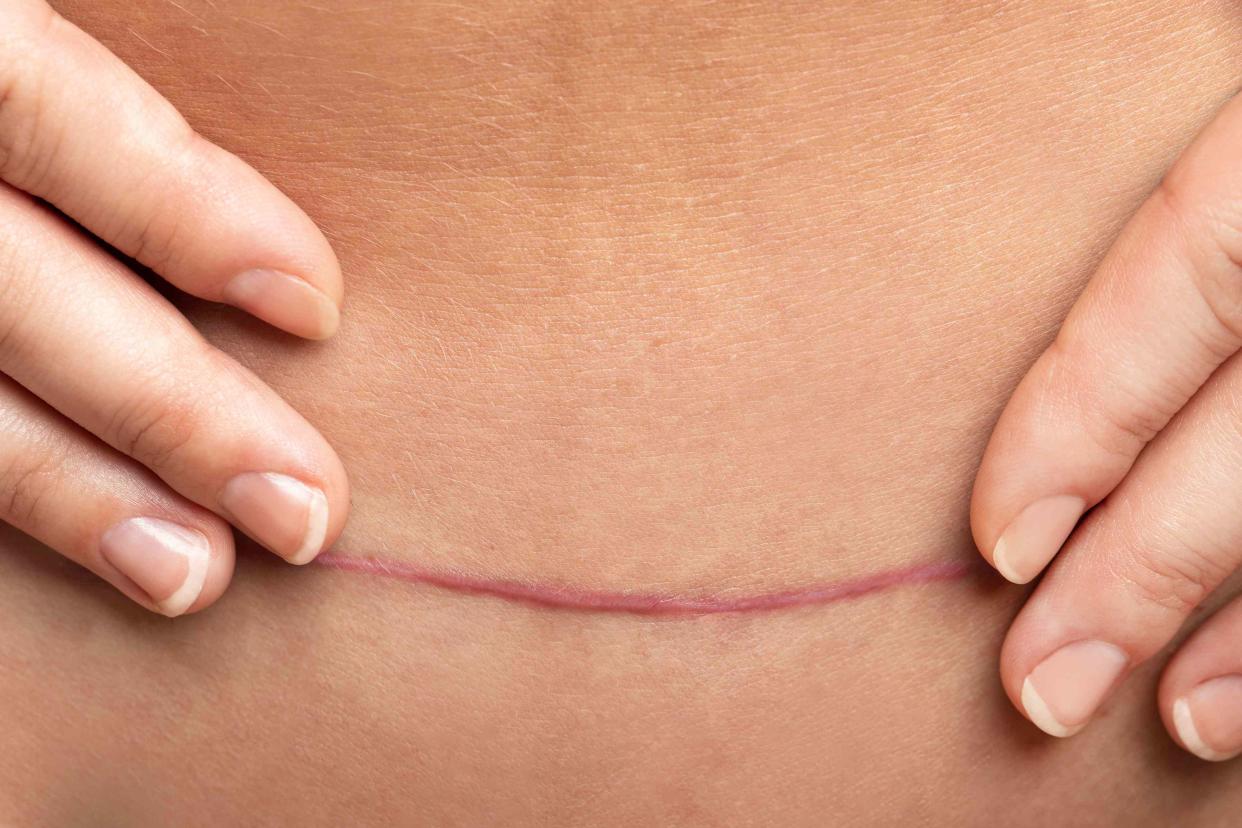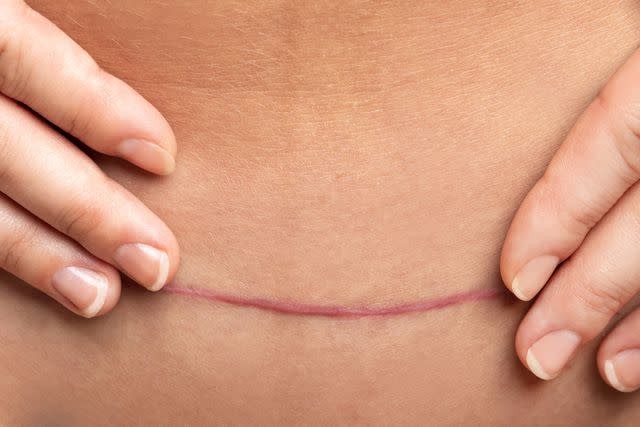What Happens During C-Section Recovery?

Jun / Getty Images
Medically reviewed by Peter Weiss, MD
Complete C-section recovery can take a few weeks, but you should notice decreased pain after the first few days. A cesarean section (also called a cesarean or C-section) is a major abdominal surgery, and what you do after surgery will influence your recovery. Your overall health and any pregnancy complications, the type of C-section you have, and your physical activity following a C-section all impact healing.
Learn what to expect during C-section recovery and what you can do to promote healing.

Jun / Getty Images
Learn More: Recovering From Surgery
C-Section Recovery: First 48 Hours
The first few days after a C-section are usually the most painful because your incision is fresh. Abdominal surgeries, like cesareans, disrupt internal tissues and muscles. However, a surgeon carefully separates the abdominal muscles instead of cutting them during a C-section.
C-sections recovery is different than other abdominal surgeries because of the myriad changes happening simultaneously in your body. In addition to healing from the surgery, recovery will also involve typical postpartum changes, including:
Body temperature changes
Shifting body fluid balances
After a C-section, you'll likely remain in the hospital for three or four days, though complications can extend your stay. During that time, medical staff will monitor you and your baby for signs of postpartum complications and assist you through the healing process.
You may receive medications to help manage blood pressure, post-surgical pain, or postpartum cramping or to prevent infections. If your C-section was planned, your healthcare provider might discuss some specific options for post-op recovery before delivery.
Move Early and Often After C-section
As soon as you can, your healthcare providers will encourage you to get up and move around slowly and carefully to aid in recovery and relieve gas. Ideally, you are up and moving to use the bathroom without a catheter in the first 24 hours after your C-section.
Related: An Overview of Nerve Pain After Abdominal Surgery
C-Section Recovery: When You Get Home
You are usually discharged home as soon as your healthcare provider is sure you and your baby are not at risk of any immediate postpartum complications. Still, this doesn't mean that going home after a C-section is easy.
You will undergo typical postpartum body changes, including hormonal shifts and vaginal bleeding. Even after a C-section, expect vaginal bleeding during the first three to four weeks after delivery, with additional discharge possible for up to six weeks. Postpartum bleeding and cramping are part of the involution (shrinking) process as your uterus contracts to its pre-pregnancy size.
During this time, it's important to stay active to prevent blood clots and regain strength. Activity restrictions and incision care after a C-section can complicate the physical and emotional changes after delivery.
Involving your partner, family, and friends in your postpartum life can help you manage the physical and emotional challenges that follow a C-section.
You will be advised not to lift anything heavier than your baby for at least the first few weeks and limit physical activity and housework. Rigorous activity and heavy lifting could cause problems for both your post-op recovery and postpartum healing.
C-Section Recovery Complications
About one-third of all babies in the United States are delivered by C-section. Most of the time, recovery goes smoothly. When you go home, your healthcare provider will advise you to watch for the following symptoms:
Fever
Sudden pain at the incision site or in the abdomen
Discharge or discoloration at the incision site
Foul-smelling vaginal discharge
Hives or rash
Blood in your urine
Heavy vaginal bleeding (soaking through more than one pad per hour)
Wound opening
Call 911 or visit an emergency department if you develop a high fever (over 103 degrees), shortness of breath, or hives.
You can help reduce your risk of complications by avoiding:
Heavy lifting
Soaking in a bath or hot tub
Strenuous activity or exercise
Tampon use
Sexual activity
At your postpartum checkup, your healthcare provider will inform you when you can safely resume these activities.
Incision, Internal Pain, and Other Healing in C-Section Recovery
After a C-section—like other abdominal surgeries—you will need time to recover from the surgical incision, blood loss, and potential nerve damage. C-sections can be performed in a few ways, and healing depends on the surgical method and the reason for the cesarean.
Low transverse: Low transverse or "bikini cut" is a low, horizontal incision offering a less obvious incision after recovery, a less invasive approach, and less trauma to abdominal tissue and muscles. The drawback, however, is that this technique offers a smaller space to deliver the baby and may not be feasible or safe in all deliveries.
Classic incision: A vertical cut in the abdomen to expose the uterus and deliver the baby provides ample space and quick access for safe delivery. It results in a much larger incision that can affect more muscle and tissue than the lower transverse method, leaving a more prominent and noticeable scar after healing.
What Type of C-section Will I Have?
Your healthcare provider will likely use the low transverse technique if you have a planned C-section. However, emergency C-sections (especially those due to fetal distress) often require larger incisions like the classic method to deliver your baby quickly and safely.
Postpartum Check-up in C-Section Recovery
Between 25% and 97% of American mothers attend their postpartum checkups. This visit is essential for everyone postpartum to monitor physical and emotional recovery after childbirth.
Postpartum checkups are crucial after cesarean delivery because there are additional risks of infection or surgical complications.
Expect to return to see your healthcare provider about three weeks after your C-section. If you experience complications after delivery, like significant blood loss or high blood pressure, your healthcare provider will want to see you between two and 10 days after delivery.
You will have an additional postpartum visit around 12 weeks after delivery. During your postpartum healthcare visits, your provider will ask about or check your:
Incisional pain and healing
Postpartum bleeding
Uterus size and location
Hormone changes
Sexual health
Infections
Emotional recovery and bonding with your baby
Breastfeeding
Your healthcare provider may offer certain medications for pain management or to support your recovery. They may suggest antibiotics or additional treatments if you are having difficulty healing or experiencing any problems with your C-section incision.
Incision Care
Some products to help aid incision healing include:
Medical-grade honey
Petroleum jelly
Antibiotic ointments
If you're concerned about scarring, consider scar massage and silicone gel after your incision has healed. Talk to your healthcare provider about supplements or natural remedies before using them postpartum, especially if you are breastfeeding.
Support for Birthing Parents in C-Section Recovery
C-section recovery and adjusting to a postpartum routine with your new baby can be mentally and physically challenging. Hormone shifts can add emotional strain to the physical healing process, as do the responsibilities of caring for a newborn.
Involving your partner, healthcare provider, family, friends, support groups, or other community resources can help you navigate this period. Some people hire a postpartum doula to help with the transition.
Different insurance companies and public health programs may offer this as well as additional resources during the recovery period. Various organizations provide maternal mental health support.
Don't wait to get help if you experience feelings of hopelessness, despair, severe depression, or think of hurting yourself or your baby. These could be signs of postpartum depression, and help is available.
Self-Care During C-Section Recovery
Take time and make an effort to care for yourself after a C-section; it is important for you and your baby. Good self-care in this stage can help you fare better in future pregnancies, avoid future health issues, and create a healthier and happier environment for you and your baby. Focus on the following areas of self-care:
Rest
Nutrition
Asking for help (so you can take time for yourself)
Related: Postpartum Physical Therapy
Summary
C-sections are common, but remember, they are still major surgical procedures. The healing process takes time, but adhering to your healthcare provider's recommendations, watching for signs of complications, and resuming light physical activity can support the healing process. Talk to your provider about ways to manage and prevent having to deal with surgical issues alongside life with a newborn.

